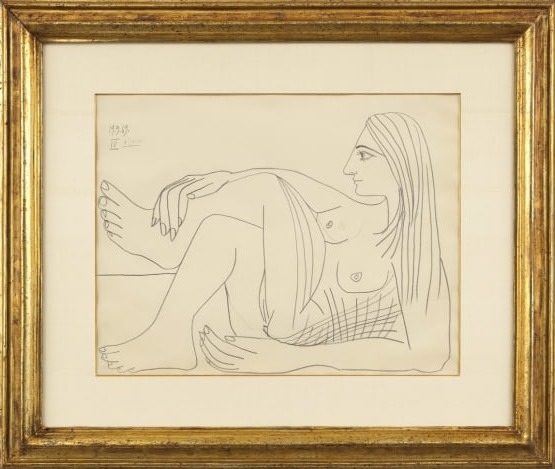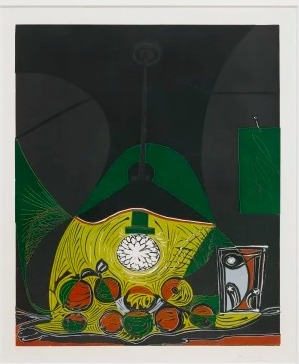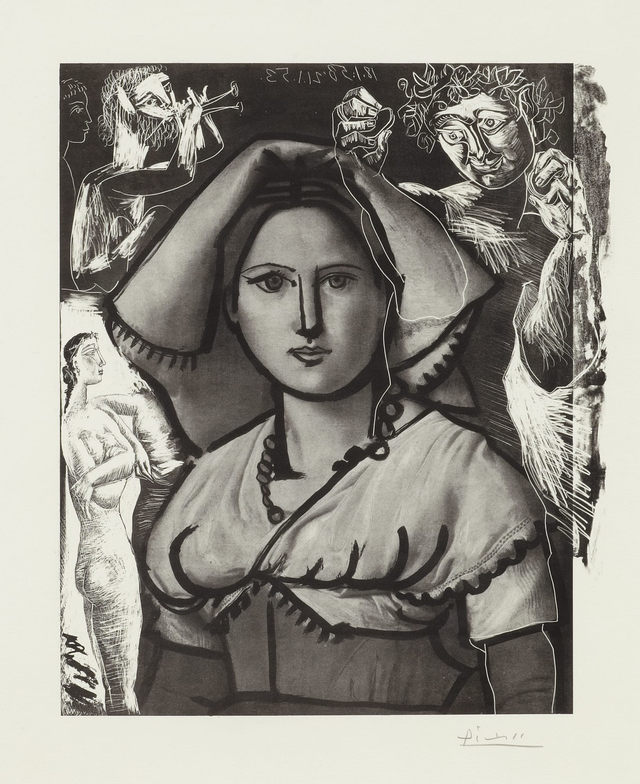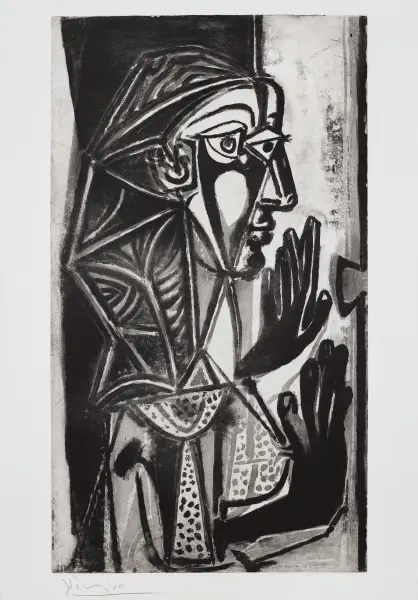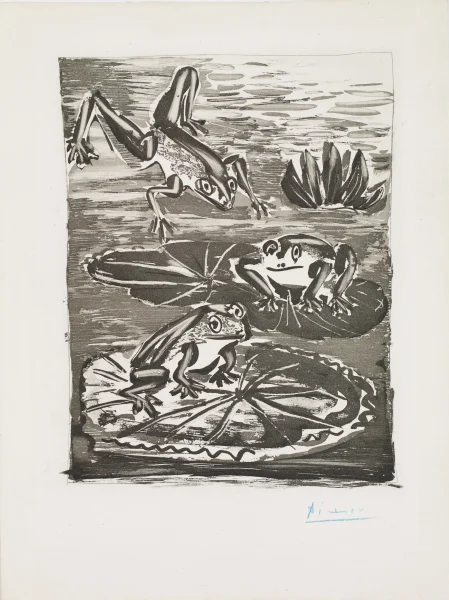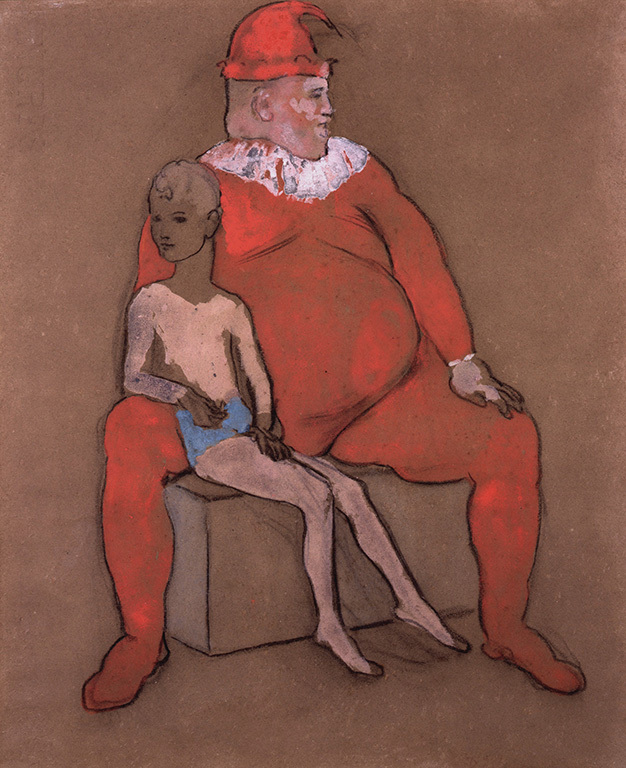
Pablo Picasso
Pablo Picasso was a multifaceted artist who excelled in various artistic disciplines. He is renowned for several iconic masterpieces, including the proto-Cubist painting "Les Demoiselles d'Avignon" (1907) and the powerful anti-war artwork "Guernica" (1937).
Biography of Pablo Picasso
Pablo Picasso was born in 1881 in Málaga, Spain. From a young age, Picasso showed a great passion for art. His artistic journey began under the guidance of his father, who recognized his son's exceptional talent and nurtured it. By the age of seven, Picasso had received formal training in drawing and oil painting.
In 1895, the Picasso family moved to Barcelona, where Picasso continued his artistic education. Soon he was enrolled at Madrid's esteemed Real Academia de Bellas Artes de San Fernando. The constraints of the academy's curriculum and the rigid approach to artistic education did not resonate with his free-spirited and independent nature.
Picasso's Artistic Journey: From Academic Realism to Modernism and Beyond
Picasso's artistic education under the guidance of his father began before 1890. During the mid-1890s, Picasso's art expression demonstrated a distinct academic realism, reflecting the traditional artistic conventions of the time. This stylistic influence is exemplified in a significant composition titled "The First Communion" (1896), a sizable artwork capturing the image of his sister, Lola.
By 1897, Picasso's artistic style underwent a notable shift influenced by Symbolism. Following this Symbolist influence, Picasso entered what is often referred to as his Modernist period, which spanned from 1899 to 1900. During this time, he found inspiration in the works of influential artists such as Dante Gabriel Rossetti, Théophile Steinlen, Henri de Toulouse-Lautrec, and Edvard Munch.
In a significant transition, the artist began to adopt the signature "Picasso" for his artwork, marking a shift in his artistic identity. This change in signature occurred in 1898.
In 1900, Picasso embarked on his journey to Paris. It was a significant milestone in his life and career, as the city would play a pivotal role in shaping his artistic trajectory.
Between January and May (1901), Picasso resided in Madrid, where he embarked on a collaborative venture with his anarchist friend Francisco de Asís Soler. Together, they co-founded a magazine called "Arte Joven" (Young Art), a platform that aimed to promote and showcase emerging artistic talent.
In 1907, Picasso made a significant move in his artistic career by joining an art gallery in Paris. This gallery was established by Daniel Henry Kahnweiler, a renowned German art historian and collector, as a platform to promote and showcase innovative contemporary art.
Picasso's Periods of Innovation and Transformation
Pablo Picasso's artistic journey can be categorized into several widely recognized periods.
The Blue Period (1901–1904)
This period saw Picasso dividing his time between Barcelona and Paris, exploring new artistic avenues and refining his creative expression. Picasso's work took on a melancholic tone, characterized by somber and monochromatic paintings. In the autumn of 1901, Picasso embarked on a series of posthumous portraits dedicated to his dear friend Carlos Casagemas. Over this period, Picasso's artistic exploration culminated in a notable and evocative allegorical painting titled "La Vie" (1903).
The Rose Period (1904–1906)
Transitioning into the Rose Period, Picasso's palette brightened, and his subject matter shifted to circus performers, harlequins, and scenes imbued with a sense of joy and optimism. During this period, his palette transformed to incorporate lighter tones, with vibrant hues of orange and pink taking center stage. In 1904 Picasso crossed paths with Fernande Olivier, a bohemian artist who became his mistress and appeared in numerous of Picasso's paintings from the Rose Period.
During this period, Picasso had the privilege of creating two notable portraits — one of Gertrude Stein herself and another of her nephew, Allan Stein. These portraits exemplified Picasso's artistic prowess and served as a testament to his growing reputation and recognition within artistic circles.
The African-influenced Period (1907–1909)
This period is characterized by a bold and expressive style featuring simplified forms, geometric shapes, and a departure from naturalistic representation. This transformative phase in his career was ignited by the creation of his renowned painting, "Les Demoiselles d'Avignon." In this artwork, Picasso incorporated elements of African art that had a profound impact on his creative process.
Analytic Cubism (1909–1912)
Analytic Cubism is a style developed by Picasso and Georges Braque. Both artists deconstructed objects and depicted them from multiple viewpoints. This period marked a revolutionary approach to representation, challenging conventional notions of form and space.
During these years, when Picasso resided in Paris, he cultivated a vibrant circle of friends. Among esteemed companions were renowned individuals such as André Breton, Guillaume Apollinaire, Alfred Jarry, and Gertrude Stein.
Synthetic Cubism (1912– 1919)
Building upon Analytic Cubism, Synthetic Cubism brought collage elements into the mix, incorporating materials such as newspaper clippings and fabric into the artwork. Picasso created a series of paintings depicting highly geometric and minimalist Cubist objects, for example, pipes, guitars, and glasses.
Picasso's Artistic Evolution Amidst World War I and Personal Relationships
In August 1914, Picasso lived in Avignon. World War I swept away many artists and friends from his Cubist circle, as Braque and Derain were mobilized, and Apollinaire enlisted in the French artillery. However, amid the upheaval, the Spaniard Juan Gris remained, providing a familiar presence within the artistic community.
The impact of the war on Picasso's art was profound. The somber tone of the war permeated his paintings, reflecting the weight of the times and the collective anguish felt by humanity.
In the aftermath of the tumultuous era that was World War I, Picasso embarked on a new artistic chapter characterized by a neoclassical style. This period represented a departure from the avant-garde experimentation of his earlier works, as he delved into a more classical aesthetic.
In the summer of 1918, Picasso married Olga Khokhlova, a talented ballerina who graced the stages of Sergei Diaghilev's troupe. Their union brought forth the joyous arrival of a son, Paulo Picasso.
In 1927, Picasso met a young woman Marie-Thérèse Walter. Picasso's connection with Marie-Thérèse Walter unfolded in secrecy. Picasso and Marie-Thérèse had a daughter named Maya.
Picasso's Resilience and Artistic Evolution During World War II and Beyond
Throughout the tumultuous period of World War II, Picasso chose to remain in Paris, even as the city fell under German occupation. His artistic style, characterized by its boldness and innovation, contrasted sharply with the Nazi regime's idealized vision of art. Despite the challenging circumstances surrounding him, he continued to paint with unwavering determination, channeling his emotions and observations onto canvas.
During this period, Picasso produced notable works that spoke volumes about the turmoil and anguish of the era. One such piece, "Still Life with Guitar" (1942), captured the essence of a world in turmoil, juxtaposing everyday objects with a sense of unease and tension. Another significant work was "The Charnel House" (1944–48). This monumental painting delved into the horrors of war, depicting a scene of carnage and destruction.
Following the liberation of Paris in 1944, a significant turning point occurred in Picasso's personal life. At the age of 63, the renowned artist embarked on a romantic relationship with a young art student, Françoise Gilot, who was 40 years younger. Picasso and Gilot decided to live together, forging a new path as partners and companions.
During the 1950s, Picasso embarked on a captivating artistic exploration that led him to reinterpret the works of the great masters who had come before him. This period marked yet another significant shift in his style and creative approach. One notable series that emerged during this time was Picasso's reinterpretation of Diego Velázquez's renowned masterpiece, "Las Meninas."
In his later years, Picasso experimented with different styles, moving towards a more classical and traditional approach. He explored sculpture in depth and produced numerous notable works in this medium. Picasso's artistic genius and creativity remained undiminished until his death on April 8, 1973, in Mougins, France.
Picasso's works have been exhibited in museums and galleries worldwide, including the Museum of Modern Art in New York, the Tate Modern in London, and the Picasso Museum in Barcelona.
Years:
Born in 1881
Country:
Spain, Málaga, Andalusia
Gallery:
Galleria d'Arte Maggiore g.am.
Galerie Thomas
Van de Weghe
Cristea Roberts Gallery
Richard Nagy Ltd.
Luxembourg + Co.
ACQUAVELLA
Landau Fine Art
Helly Nahmad Gallery
Tornabuoni Art
Galerie Michael Haas
Galerie Knoell
Vedovi Gallery
Gagosian
ACA Galleries
